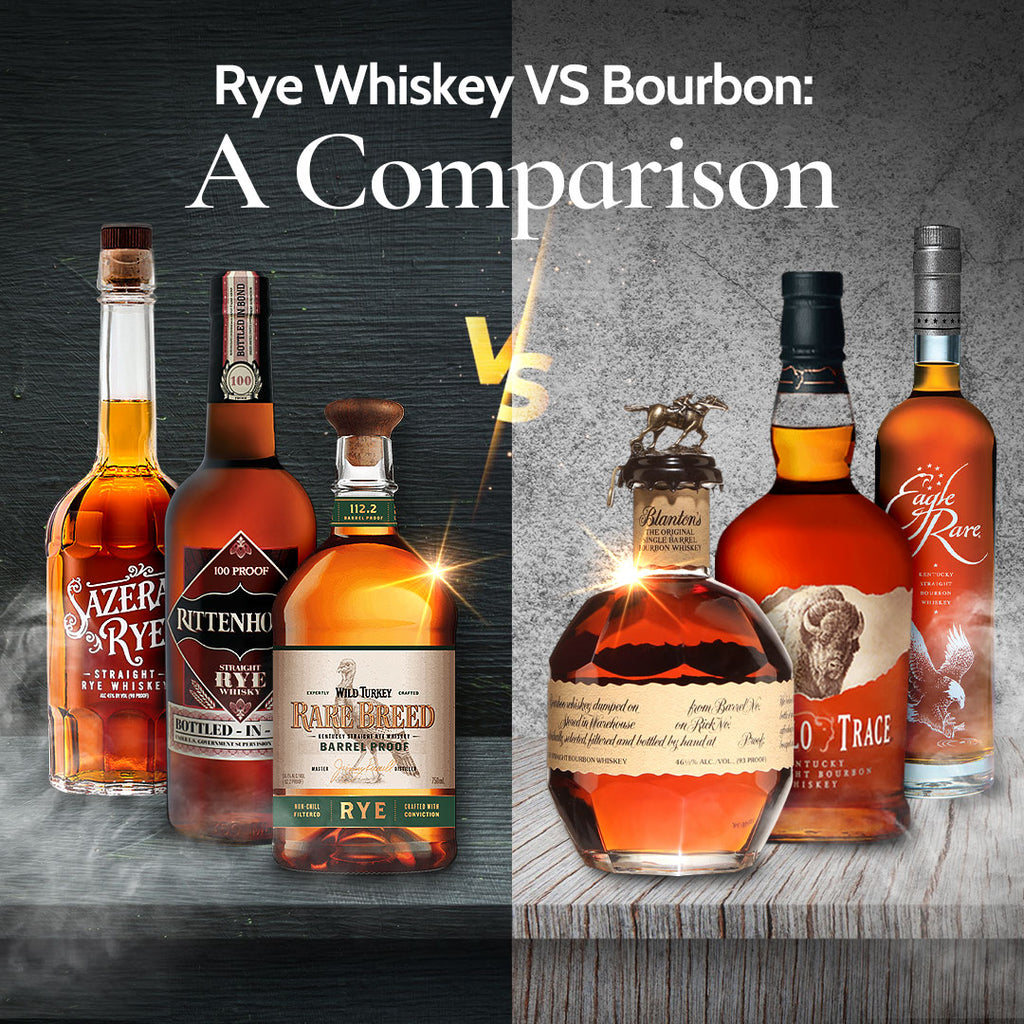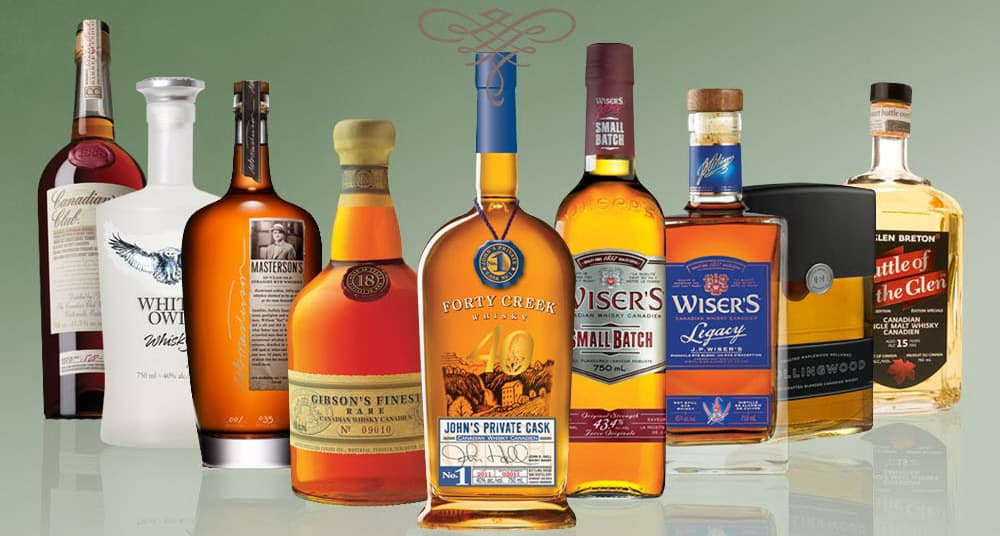When it comes to spirits, the world of whiskey offers a diverse range of tastes and traditions. Understanding the differences among various varieties like Canadian Whiskey and Bourbon adds richness to the appreciation of this distilled art.
In this blog post, we delve into the distinct characteristics that set Canadian Whiskey vs Bourbon, shedding light on the unique flavors and processes that make each variety a celebration of craftsmanship. So pour yourself a glass, sit back, and let’s explore the intricate world of whiskey together.
Canadian Whisky: A Smooth and Distinctive Spirit

Canadian whisky boasts a unique taste that stands out from other whiskies. This distinct flavor comes from a combination of factors, including how it’s made, how long it’s aged, and the grains used.
Canadian whisky is known for being smooth and mellow, often with notes of caramel, vanilla, and oak. This smoothness comes from blending different grain spirits, with rye playing a prominent role. Whether you enjoy it neat, on the rocks, or in a classic cocktail, Canadian whisky offers a delightful drinking experience for any whiskey lover.
Unveiling the Secrets of Canadian Whisky
Canadian whisky has a rich history and a unique production process that shapes its distinct flavor. It all began in the late 18th century when Scottish and Irish immigrants brought their whisky-making skills to Canada.
Canadian whisky is typically made by blending various grain spirits like corn, rye, barley, and wheat. These spirits are then aged in oak barrels for at least three years. This unique blending process, along with high-quality grains, creates the smooth and mellow flavor profile that sets Canadian whisky apart. The aging in oak barrels adds depth and complexity to the final product.
A World of Flavor in Every Sip
Canadian whisky offers a surprising range of flavors, from rich and robust to light and sweet. The combination of high-quality grains and the blending process creates a smooth and mellow base. Some Canadian whiskies lean towards fruity and floral notes, with hints of vanilla, caramel, and oak peeking through from the aging process. Others feature spicier, peppery flavors due to the rye grain. This variety of flavor profiles makes Canadian whisky a versatile choice that can cater to different palates and drinking occasions.
Bourbon: A Spirited American Tradition

Bourbon is a uniquely American whiskey with a rich history and distinct flavor profile. Unlike other whiskeys, bourbon has a strict set of regulations that define its production process.
The Heart of Bourbon: Corn and Oak
At its core, bourbon must be made with at least 51% corn, giving it a characteristic sweetness. This corn mash is then fermented and distilled before being aged in new, charred oak barrels. These charred barrels are what truly set bourbon apart. The charring process imparts deep flavors of caramel, vanilla, and spice into the whiskey, creating the rich and complex taste bourbon is known for.
The Bourbon Distillation Process: From Grain to “White Dog”
The journey of bourbon begins with milling grains, primarily corn, into a coarse meal. This meal is then cooked to convert starches into sugars that yeast can readily consume. Yeast is then added to the mixture, and fermentation begins. Over several days, the yeast transforms the sugars into alcohol, creating a beer-like liquid called “distiller’s beer.” Finally, this distiller’s beer is passed through copper stills, separating the alcohol (ethanol) from unwanted impurities. The resulting product is a clear liquor known as “white dog” – the foundation for all bourbon.
Aging and Maturation: Where Bourbon Comes Alive
The aging process is where bourbon truly comes into its own. The “white dog” is placed in new, charred oak barrels and left to mature for a minimum of two years. However, many bourbons are aged for much longer, some for decades. During this time, the bourbon interacts with the charred wood, extracting flavors and developing its characteristic amber color. The charring also helps to smooth out the harsh edges of the young spirit, resulting in a well-rounded and mellow taste. The length of aging significantly impacts the final flavor profile, with older bourbons often boasting deeper and more complex characteristics.
The Key Differences and Similarities Between Canadian Whiskey and Bourbon
| Aspect | Canadian Whiskey | Bourbon |
|---|---|---|
| Production | Often made using a blend of grains and aged in used barrels. | Made primarily from corn and aged in new charred oak barrels. |
| Flavor | Tends to have a lighter, smoother profile. | Offers a richer, oaky taste. |
| Regulations | Has fewer regulations, allowing for more flexibility in production methods. | Subject to stricter regulations. |
| Type of Whiskey | Grain mash | Grain mash |
| Aging | Must be aged for a specific period to meet legal requirements. | Must be aged for a specific period to meet legal requirements. |
Canadian Whisky vs. Bourbon: Grain Games

The grains used to make Canadian whisky and bourbon are key ingredients that shape their distinct flavors.
- Canadian Whisky: This is a blend! It uses corn, rye, and barley, sometimes up to 20 different grains, to create a lighter and smoother taste.
- Bourbon: The law requires at least 51% corn, and the rest can be rye, barley, or wheat. This corn-heavy mash bill gives bourbon its signature sweetness.
Canadian Whisky: A Grain Symphony
Canadian whisky is a masterpiece of blending. Corn, rye, and barley are just the beginning, with some recipes using up to 20 grains! This unique combination creates a smooth, light-bodied whisky that’s perfect for those who prefer a mellower taste.
The grains are milled, mashed, fermented, and then distilled. Distillation involves heating the mash to release alcohol vapors, which are then captured and transformed into whisky.
Bourbon: All About the Corn
The mash bill, the grain recipe, is crucial for bourbon. By law, it must be at least 51% corn. This corn-forward approach gives bourbon its characteristic sweetness. Rye, barley, and wheat can also play supporting roles, influencing the final flavor profile.
After milling and mashing, the grains undergo fermentation, followed by distillation. Similar to Canadian whisky, distillation involves capturing the alcohol vapors produced by heating the mash. These vapors are then aged to create the final bourbon product.
Canadian Whiskey vs. Bourbon: A Taste Exploration

Understanding the unique flavor profiles of Canadian whiskey and bourbon is key to appreciating these distinct spirits.
Canadian Whiskey: Smooth and Light
- Known for its smooth, light taste.
- Common tasting notes include caramel, vanilla, and fruity hints.
- The smooth character and subtle sweetness make it a favorite among many whiskey drinkers.
Bourbon: Rich and Bold
- Offers a richer, bolder taste compared to Canadian whiskey.
- Typical flavors include oak, spice, and varying degrees of sweetness.
- The specific flavor profile can vary depending on the grain used, the aging process, and the distillery’s methods.
- Bourbon boasts a wide range of flavors, with each brand and expression offering something unique.
Exploring the Differences
To truly appreciate the nuances, enjoy a glass of each side-by-side. Savor the smoothness of Canadian whiskey and the richer notes of bourbon. Experiment with sipping them neatly, using them in cocktails, or pairing them with different foods to discover your favorite way to enjoy each spirit.
Remember: Always drink responsibly and savor every sip!
Canadian Whisky and Bourbon: Perfecting Your Food Pairings

Whisky can be a wonderful companion to food, elevating your dining experience. Canadian whisky and bourbon, with their distinct profiles, offer unique pairing opportunities.
Canadian whisky’s light and smooth character shines when paired with lighter flavors. Think seafood! Grilled salmon or shrimp pair beautifully, with the whisky complementing their delicate taste. For a delightful dessert pairing, explore creamy options like crème brûlée or vanilla ice cream. The sweetness of these treats accentuates the subtle sweetness in the whisky, creating a harmonious finish.
Bourbon’s rich, oaky notes and smooth finish make it a versatile partner for savory dishes. Grilled meats like steak or pork chops find a perfect match with bourbon’s bold character. Don’t shy away from smoky barbecue ribs or crispy fried chicken – bourbon’s sweetness balances these savory flavors beautifully. And for a decadent dessert pairing, explore pecan pie or dark chocolate. The complex flavors of bourbon add depth and richness to the entire experience.
These are just starting points! The key is to experiment and discover your perfect pairings. Don’t be afraid to try different combinations and find what excites your palate.
Conclusion: Canadian Whiskey vs. Bourbon: A World of Flavor
Canadian whiskey and bourbon are two popular types of whiskey, but they have distinct characteristics. Whether you enjoy the smooth lightness of Canadian whiskey or the bold, oaky notes of bourbon, there’s a perfect whiskey for you. As you explore these spirits, take a moment to appreciate the craftsmanship and heritage behind each bottle, savoring the intricate flavors within.
Understanding the Differences and Similarities
While Canadian whiskey and bourbon share some common ground, there are key differences to consider:
- Production: Canadian whiskey is often a blend of grains aged in used barrels. Bourbon, on the other hand, is primarily corn-based and aged in new, charred oak barrels. This difference influences the final flavor profile.
- Flavor: Canadian whiskey tends to be lighter and smoother, while bourbon boasts a richer, oakier taste due to the new charred barrels.
- Regulations: Canadian whiskey has fewer restrictions compared to bourbon, allowing for more flexibility in the production process.
Here’s what unites these whiskeys:
- Grain Base: Both are whiskeys, meaning they’re distilled from fermented grain mash.
- Aging Requirements: Both Canadian whiskey and bourbon must be aged for a minimum period to meet legal standards.
- Versatility: Both offer a range of flavors and can be enjoyed neat, on the rocks, or in cocktails.
Understanding these distinctions allows you to appreciate the unique qualities of each spirit.
References:
- https://fortycreekwhisky.com/blog/difference-between-types-of-whiskies/
- https://www.quora.com/What-is-the-difference-between-Canadian-and-bourbon-whiskeys
FAQ About Exploring Whiskey Varieties: Canadian Whiskey Vs Bourbon
Q: What is the main difference between Canadian Whiskey and Bourbon?
A: The main difference lies in their production methods. Canadian Whiskey is typically made from a blend of grains and is known for its smooth, light flavor. On the other hand, Bourbon is mainly made from corn and has a sweeter, more robust taste due to the charred oak barrels used in aging.
Q: Are there specific regulations that distinguish Canadian Whiskey from Bourbon?
A: Yes, both Canadian Whiskey and Bourbon must adhere to certain regulations to be classified as such. Canadian Whiskey must be aged for at least three years in wooden barrels, while Bourbon must be made with at least 51% corn and aged in new, charred oak barrels.
Q: Which whiskey variety pairs better with certain foods?
A: Canadian Whiskey’s lighter flavor profile makes it a versatile choice for pairing with a variety of foods, especially seafood and poultry. In contrast, Bourbon’s bold and sweet taste complements dishes with rich flavors like barbecue and grilled meats.
Q: Can Canadian Whiskey and Bourbon be used interchangeably in cocktails?
A: While Canadian Whiskey and Bourbon can be used interchangeably in some cocktails, their distinct flavors may affect the overall taste of the drink. It’s best to experiment and see which whiskey variety complements the cocktail ingredients better.
Q: Are there notable brands known for producing high-quality Canadian Whiskey and Bourbon?
A: Yes, there are several renowned brands in the market known for their exceptional Canadian Whiskey and Bourbon offerings. Some popular Canadian Whiskey brands include Crown Royal and Canadian Club, while Bourbon enthusiasts often turn to names like Maker’s Mark and Buffalo Trace for top-notch choices.
Q: What should one consider when choosing between Canadian Whiskey and Bourbon?
A: When choosing between Canadian Whiskey and Bourbon, consider your taste preferences and the occasion. If you prefer a lighter, smoother whiskey, Canadian Whiskey may be your go-to. However, if you enjoy a sweeter, more robust flavor profile, Bourbon could be the perfect choice for your whiskey exploration.
